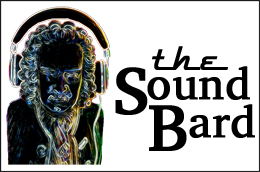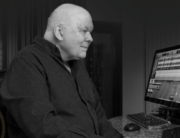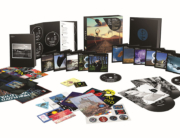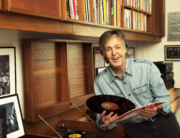BY MIME METTLER & RYAN ULYATE – SEPTEMBER 26, 2014
Editor’s Note: I’ve been friends with producer/engineer Ryan Ulyate for years, and I’ve been honored to sit next to the man a few times in his Topanga Canyon studio while he contemplated the scope of the whatever 5.1 project was next on his mixing plate. After we recently discussed the hi-res-oriented production work he did for Tom Petty & The Heartbreakers’ sonically stellar new album Hypnotic Eye, I asked Ryan if he’d like to co-author an article explaining his passion for high-resolution audio, not only from the producer’s POV, but from the perspective of an inveterate lover of hearing music in its highest form. “How soon can I get started?” was his instant reply (well, the P.C. version of it, that is). I also asked Ryan to be on my “High Fidelity First Class: Why High Resolution Audio Keeps on Growing” panel alongside David Chesky of HDtracks at the New York Audio Show in Brooklyn on September 27, 2014. Welcome aboard, Ryan. To borrow a phrase: Damn the torpedoes! —Mike Mettler, The SoundBard
As a producer and engineer, I’ve been making records for over 35 years. My goal has always been to take the immediacy, excitement, and nuance of what we record in the studio and get it to the public in its purest possible form. So how can we get exactly what we’re hearing in the control room to the listener with as little compromise as possible?
I’m happy to say that with hi-res audio being made more widely available, everyone can hear exactly what we hear when we make albums. This is a great leap forward!
Up to now, keeping the audio quality high hasn’t been easy. It has always involved compromise and adjusting to the different sonic signatures of various audio formats used to produce an album. To understand why, I’ll give you a little background.
When I started engineering professionally in 1979, we recorded everything on 2-inch analog 24-track tape. Lets go back to that time and make a record, shall we? The process went like this. The band showed up to record the basic tracks in the studio. We set up mics and listened through an analog board, sending the various instruments to a multitrack tape machine for recording. As soon as we recorded a take and played it back, the sound changed. Analog tape imparted its character to the sound. It added hiss, and changed the frequency response. Low frequencies were reduced and high frequencies were rolled off, or had a peak. It also induced distortion, especially if you recorded the tape with too much level — which, to many, including noted producer Roy Thomas Baker (Queen, The Cars), was a good thing! The bottom line was that it sounded different on playback than it did on input. From the very beginning, we were working with something that wasn’t what we started out with.
When we had everything on tape, we could EQ it again, based on what the tape sounded like. If you’re a sonic purest, every time you add EQ, you degrade the sound as it induces phase errors and subjects the analog signal to more electronics. But that’s okay; we’re making records — not art… right? Whatever it takes to make something exciting, we did. If the sound was slightly degraded, that was the price we had to pay.
Now our basic tracks were finished and we’d start overdubbing. This meant playing back the 24-track tape over and over as new instruments and vocals were added. After we were done with overdubs, it was time to mix, but somehow our drums lost their punch and the cymbals were not as bright. That’s because the tape had passed over the playback head so many times and it wore off some of the iron oxide. Now all the basic tracks were duller. Degradation again! Time for more EQ.
We finished our overdubs, and it was time to mix. We set up the stereo mix, using the console and all sorts of outboard devices, and prepared to record to ¼-inch or ½-inch 2-track analog tape. We got the mix sounding as good as we could, but when we played back the mix from the 2-track, it sounded different again! We’d taken our entire mix and put another layer of hiss, distortion, and non-linear analog frequency response on it by recording it to 2-track. It sounded a bit “smaller” and hissier, but we got used to it. And that was our stereo master.
Then it was time for mastering for vinyl — and don’t forget cassette! We went to a mastering studio and listened again. We took the 2-track analog tape and added more EQ and/or compression/limiting so we could cut it to vinyl. The 2-track tape was sounding as good as we could get it. We cut a reference, or ref, disc on vinyl, straight from the cutting head of the lathe.
We listened to the ref disc. Now that really sounded different! We had gone from magnetic tape to grooves in plastic, played back with a turntable and cartridge — a big audio change. Yep, everything sounded different. We also got static, ticks, and pops — little noises that were never on our tapes. We then adjusted the EQ going from the analog tape to the cutting lathe, and recut the tracks we wanted to sound better.
Now we had our ref disc sounding as good as it could, and we sent a pristine set of lacquers to the pressing plant. They went through several stages, and we ended up with a test pressing. Did it sound as good as the ref disc? Of course not! We did the best we could to deal with any bad noises, ticks, pops, etc., and the record was released.
This was a long journey from where we started to where we ended up!
Over time, I learned to anticipate what each stage of the process did to the sound, and began to adjust for that beforehand. Make sure that the high frequencies are exaggerated when you record basic tracks, as the drums will get duller after you do your overdubs. Know that the 2-track will “glue” the mix together more and soften it a bit, so don’t be afraid of making things sound a bit more edgy when you mix. Make sure there’s plenty of top when you master, as the vinyl will sound duller after it comes back from the plant.
In other words, understand that everything is a compromise — and accept the fact that at any given point, you are not listening to your final product. I used to drive the artists I worked with crazy. I would get comments like, “How come the mix doesn’t have the same punch as the rough mix we made when we tracked it?” “The vinyl sounds too thin.” “The cassette is too boomy!” “Oh well, I guess no one will ever be able to hear it like we did in the studio.”
Until now.
Fast-forward to 2014, and let’s look at how we produced Hypnotic Eye, the new album by Tom Petty & The Heartbreakers.
We recorded the basic tracks in the Clubhouse, the band’s instrument warehouse and private studio. They set up their instruments and we recorded them digitally, straight into ProTools at 48kHz/24-bit. (This 24-bit audio has 256 times more resolution that the 16-bit audio on a CD or MP3. For more on bit depth, check out this good article on tweakheadz.com).
When I heard the music through the control room monitors, I was listening (on “input”) to the hi-res digital audio that had gone “through” the ProTools converters and software. I was monitoring the sonic imprint that the technology imparted on the music, and I knew it would not change. Every creative decision from that moment forward was based upon the fact that we would be hearing the same quality of sound from the beginning to the end of the record. The sound stayed constant throughout the recording and overdub process. We were able to refine it as we went along, knowing that nothing would change. When we were finished with overdubs, we mixed the album “in the box” using the ProTools software.
When we finished recording and mixing, it was time to master. Since our native resolution was 48/24, we had to find a way to convert to the 44.1/16 CD resolution. Over the years, I have found that the best way to do that is to go through a digital-to-analog (D/A) converter, and then through an analog mastering console, and then back through an analog to digital converter, set for 44.1/16. With this process, the sound did finally change. There is also another factor that changes the sound when we master for CD. The digital level is increased by about 7 dB. This makes the CD about as “loud” as the majority of CDs currently released.
Many people have argued about and bemoaned the fact that we add peak limiting, but the reality is we are living in a world of heightened levels, and in order for our record to compete sonically in the marketplace, we choose to do this. Some audiophiles might disagree. To those people I say: You are free to do whatever you want on the records you produce!
So we get more level by using digital peak limiting. This takes the louder transient peaks in the audio (like drums) and reduces them, allowing more level to be put into the digital waveform without clipping. It also “glues” the mix more together. On large hi-fi systems, the effects of this can be a little unpleasant, as it tends to take the “air” and dynamics away, but on small systems — like iPod/iPhone earbuds, computer speakers, and some car stereos — this can make the music more “present” and exciting.
So, anyway, when I get to Bernie Grundman Mastering with engineer Chris Bellman, we listen to the album through the 16-bit signal chain — and, for the first time, it sounds different! So we adjust. Here’s how I approached that. I started by bringing in my computer and ProTools hardware to play back the mixes directly from the original multitrack ProTools sessions. If we needed to adjust any instrument or voice in the mix to compensate for the new signal chain we were monitoring through, we could do it. And Chris and I did! The goal was “master” from within the mix and not add any “overall” EQ, which is normally the custom in mastering. My fellow producers — Tom Petty and Mike Campbell — and I got the mix sounding as good as we could before I took it to mastering, so we didn’t want to change it very much. If any individual element needed to be brighter, duller, thinner, fatter, louder, or quieter, it was addressed by adjusting individual tracks in the mix. We finished with all the songs, one by one, and then made a ref CD to see how it sounded in the “real” world. We then went back and made further adjustments to the mixes, if necessary, until we were happy.
Now that we were done with the CD mastering, we focused our attention again on the hi-res master. The peak limiting was removed. We connected digitally to Chris’ AudioCube mastering computer, at full resolution (48/24), and we monitored the output. It sounded nice to have all that resolution and dynamic range back again! We see if the changes we made to the mixes for the CD applied to the hi-res playback. Sometimes we fiddled a bit with the low end, as this is what changes the most between the formats. We got all the mixes sounding right, and we recorded the final stereo master straight to the AudioCube. This master was used for the hi-res files on Blu-ray and FLAC. It’s also the master that we cut the vinyl from. The music is fuller, has more “air” and “punch” — just the way we made it!
So there you go. If you want the closest thing to what we heard when we made this music, buy the hi-res FLAC or Blu-ray. If you have a good system, you will hear the difference! If you buy the vinyl, you will hear how that medium colors the sound of our hi-res source. (A lot of people, including Heartbreaker Benmont Tench, love the sound that vinyl imparts to the master. We even made two vinyl releases for Hypnotic Eye: 1) a less expensive, two-sided LP on 140-gram vinyl, and 2) a deluxe three-sided LP set on 180-gram vinyl with a bonus track and an art piece etched on Side 4.
We finally live in a time where there is less compromise than ever between what the artist and producers intended their work to sound like and what the listener will hear. For an added incentive, the Hypnotic Eye Blu-ray also has a 5.1 mix, which puts you in the middle of the band. Although there are those in the audio industry have pronounced 5.1 audio dead, I’m going to do everything I can to keep it alive. It just sounds too good! [I heartily concur!—your ever-5.1-lovin’ SoundBard]
As I say on the Blu-ray sleeve, “Thank you for caring enough to invest in high quality sound.” The more of us that do this, the more the industry will respond, and the more music will be released in hi-res audio. We have the technology. We just need to spread the word and let everyone know how much better hi-res sounds! Keep clicking, and we’ll keep spreading the good word.












